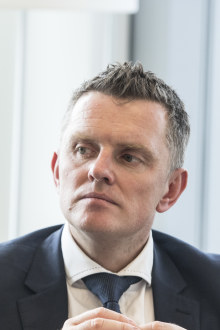Chanticleer

Why pretend portfolios are important for investment banks
Running a model portfolio avoids the gut-wrenching risk-on moment that fund managers face every day. Yet, they remain a key engagement tool for stockbrokers.
There’s a big difference between playing Mario Kart and driving a race car, or trying an indoor skydive simulator and jumping out of a plane.
It’s the same in investing. Until there is real money on the line, there is no gut-wrenching risk-on moment, no big ups and downs or sleepless nights. Ask any fund manager.

Morgan Stanley’s Chris Nicol was head of small caps research and on a camping trip a decade ago when then head of strategy Gerard Minack called to flag his retirement. Jessica Hromas
But still, the big stockbrokers run model portfolios, pulling together their research analysts’ best bottom-up stock picks, economists’ macro overlay and the quant team’s input on what’s hot, and it’s all overseen by the equities strategists.
Melbourne-based Chris Nicol and his team have been doing it at Morgan Stanley, a top-three broker in Australia by cash equities market share, for the past decade.
While Nicol is a bit sheepish about performance – he’s the first to point out that running a desktop model is very different to putting real money to work – the portfolio has knocked it out of the park; it has outperformed the benchmark S&P/ASX 200 by 28.4 per cent across that 10-year period or 1.5 per cent a year.
Right now, the portfolio is deliberately concentrated and cautious, overweight energy, healthcare and insurance names like CSL, Woodside, ResMed, Santos and QBE, and underweight each of the big four banks.
It is large-cap heavy, taking Nicol away from his old small-cap stomping ground and the stocks he initially set out to pick.
His 10 years running Morgan Stanley’s “Macro+” strategy team and the model portfolio, which he runs alongside former RBA economist Chris Read and quant specialist Antony Conte, prompted some reflections this week.
He told clients he started trying to break the typical banks-and-resources barbell mindset and embrace growth and mid caps. However, the portfolio has drifted to large caps and been more mindful of liquidity in recent times, and he has vowed to think more about smaller stocks (ex-20 and ex-50) early next year.
The model portfolio’s returns look decent on paper; 9 per cent a year annualised returns in absolute terms over 10 years, and usually a 3 per cent to 4 per cent dividend yield. However, those numbers and the whole exercise misses important things fund managers have to deal with like fees, brokerage and tax, which always makes it hard to compare a model portfolio’s numbers to real-world returns.
So, why do the model portfolio at all?
Nicol says it is an important engagement tool. He and his team will meet portfolio manager clients, explain their suggested positioning in terms of sectors, stocks and the overall portfolio, and compare and contrast that to the manager’s actual portfolio.
“If they get good ideas from that, or at least pause for thought, then I have done my job,” he says.
The model portfolio is a good way to make clients take notice of the broader research team’s ideas, he adds.
Morgan Stanley has 32 analysts covering stocks in Australia and a big global macro franchise, and Nicol’s Macro+ takes input from both.
“When we make changes in our model portfolio at the stock or sector level, it should be taken seriously that we have conviction behind it,” he says.
Old and new
Nicol was on a camping trip a decade ago when Morgan Stanley’s head of strategy, Gerard Minack, asked him if he was interested in his job.
Minack, a big name in the market and a renowned bear at the time, was retiring from bulge bracket investment banks and thought a bottom-up stock picker like Nicol could bring a new perspective to the role.

Morgan Stanley strategists Chris Nicol and Daniel Blake (right).
Nicol teamed up with economist Daniel Blake to combine the bottom-up and top-down views into the one team. “The task was to build something a bit unique,” Nicol says. Blake, an Australian, is now Morgan Stanley’s Asia and emerging market strategist based in Singapore.
Nicol and his colleagues reckon the S&P/ASX 200 is in for another sluggish year, climbing to only 7350 points by December next year. The index was at 7240 points on Wednesday.
“We see some earnings risk in the domestic side of the market going into February results,” he says.
“There is a final test for consumers with everyone caught up at once now: interest rates, energy costs etc.”
The macroeconomic situation, in Australia and globally, has been a significant driving force in markets this year and since the COVID-19 pandemic.
Morgan Stanley’s team is tipping one more interest rate rise from the Reserve Bank of Australia in February, which would take the cash rate to 4.6 per cent.
Nicol says his view is “data dependent”, meaning he will be watching January’s two inflation reports (monthly numbers for November and December) and Christmas retail sales for confirmation of that February rates call.
“We’re finally seeing consumers adjust; they’re not collapsing, they’re thrift-ing,” he says.
What’s more clear in his mind is that the RBA will lag other major central banks in terms of cutting interest rates; Australia didn’t raise as quickly or as high on the way up, so will be slower on the way down.
Nicol says 2023 has been a tough year for investors and his model portfolio, which has oscillated between 1 per cent up and 1 per cent down versus the index for much of the time.
His team’s portfolio is set to finish the year with a focus on insurance, energy, healthcare, BHP, Rio Tinto and global growers – such as Domino’s, Aristocrat, Altium and Goodman Group.
Introducing your Newsfeed
Follow the topics, people and companies that matter to you.
Find out moreRead More
Latest In Financial services
Fetching latest articles